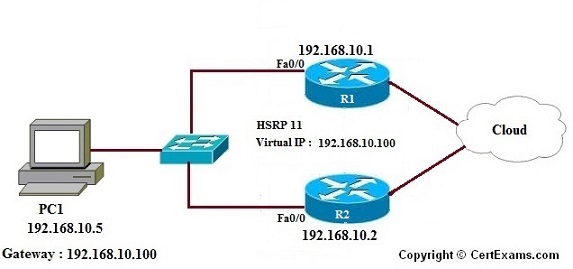CertExams.com Simulator Lab Exercises Answers
Description : This lab exercise demonstrates the necessary commands to disable the HSRP on a router.

HSRP is one of the so called FHRP or “First Hop Redundancy Protocols”. The other two FHRP protocols that are popularly known are VRRP (Virtual Router Redundancy Protocol) and GLBP (Gateway Load Balancing Protocol). In the labs, we cover HSRP.
Configuring HSRP: HSRP, or Hot Standby Routing Protocol, is a Cisco proprietary protocol that allows two or more routers to work together to represent a single virtual IP address to the end-user. Among the HSRP configured routers, one will work as Active and the others (one or more) work as Standby routers. The Active and Standby routers are determined by a set of rules. Only the virtual IP address that was created within the HSRP configuration along with a virtual MAC address is known to other hosts on the network.
The Active router is elected by considering the priority assigned (higher number means, higher priority). The default priority is 100. If two routers have the same priority, then the router with higher IP address will assume Active router role, and the other acquires Standby router role. Furthermore, if there are more than two routers in the group, the second highest IP address determines the standby router and the other router/routers are in the listen state.
Note 1: If both routers are set to the same priority, then the first router to come up will be the active router. The labs provide hands-on experience in configuring HSRP using Cisco routers and verifying the HSRP configuration.
Note 2: When replying to traceroute command, the IP address of the physical interface is used, not the virtual IP address. Similarly, as per Cisco website, when a response for traceroute is received from a hop that runs HSRP, the reply must contain the active physical IP address and not the virtual ip address.
Please refer to the CertExams.com Network Simulator software for complete lab with commands.